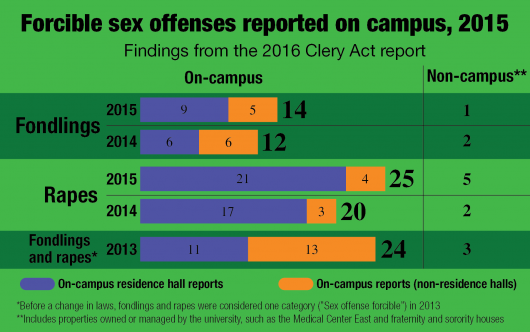
Graphic by Robert Scarpinito | Managing Editor for Design
Reports of rape and fondling on Ohio State’s Columbus campus rose in the 2015 calendar year from the year prior, according to an annual safety report released by the university. Reports of dating violence, aggravated assault and burglary increased as well.
The results come from the 2016 Annual Campus Security Report and Annual Fire Safety Report, published Friday by the Department of Public Safety, as mandated by the federal Clery Act.
Crimes reported on campus that saw a decrease in reporting include domestic violence, which decreased from five reports to four; stalking, which decreased from 19 reports to 15; and motor vehicle theft, which decreased from 11 reports to three.
There were 25 rapes reported on campus, along with five reported under the classification “non-campus.” As defined by the Clery Act, non-campus includes university-managed property not directly on-campus, such as fraternity and sorority housing, University Hospital East and offices rented by the university across the county. Twenty-one of the 25 rapes reported were reported in residence halls.
“It’s kind of a double-edged sword … A huge focus is to increase reporting.” — Dan Hedman, spokesman for the Office of Administration and Planning
On-campus reports of fondling increased from 12 to 14 for the 2015 calendar year. In 2013, federal reporting requirements combined data for fondling and rape, listed under “sex offence forcible,” and the on-campus total was 24.
While an increase in reported forcible sex crimes is not something the university wants to hear, Dan Hedman, spokesman for the Office of Administration and Planning, said it also means that people are coming forward.
“It’s kind of a double-edged sword,” Hedman said. “A huge focus is to increase reporting.”
The recently released 2016 Ohio State Campus Climate Survey on Sexual Misconduct reported that 20.6 percent of female student respondents and 5.5 percent of male student respondents experienced “nonconsensual sexual contact by physical force, threats of physical force, or incapacitation,” although that survey sampled students across the student body regardless of whether or not the crime occurred on-campus, whereas the Clery Act is limited to on-campus reports.
The Clery Act report follows specific federal requirements. It includes all the crimes that fall into 16 categories, and were reported to have occurred on-campus, in certain non-campus buildings or property owned or controlled by the university, and on public property within or immediately adjacent to and accessible from campus. Crimes are listed regardless of if they were reported by students or unaffiliated persons.
Burglary, as defined by the Clery Act, is the theft of an item from a location where a person is not authorized to be. This wouldn’t include the theft of a laptop from a dorm room, for example, said Kellie Brennan, OSU’s Title IX coordinator, because it could have been stolen by a student with access to the residence hall. Unless it was proven that it was stolen by someone not authorized to be there, it would not be counted.
Overall, “major on-campus crime” — which includes aggravated assault, arson, burglary, homicide, motor vehicle theft, rape, robbery, theft and theft from motor vehicle — has fallen from 803 incidents in 2011 to 477 in 2015, Hedman said in a follow-up email.
“(The) Department of Public Safety utilizes a combination of sworn police, uniformed security and surveillance and technology to deter crime on our Columbus campus,” Hedman said. “(University Police) reinitiated bike patrols to more effectively patrol campus, as well as enhance community interaction and proactive policing.”
For 2015, arrests and disciplinary referrals for alcohol law violations decreased on campus. In 2013 and 2014, 197 and 200 people were arrested on campus for alcohol violations, respectively, compared to 119 arrests in 2015.
Meanwhile, arrests for drug violations increased in 2015, with 46 arrests. That compares to 30 arrests in 2014 and 25 arrests in 2013.
“A lot of work has been done to address alcohol and drug use,” Brennan said.
Brief Alcohol Screening and Intervention for College Students, known as BASICS, and the Cannabis Screening and Intervention for College Students, or CASICS, are two programs offered by the university which provide information and guidance regarding alcohol and marijuana.
The goals of these two programs are to reduce risky behaviors involved with alcohol and marijuana use.
“With the North Residential District opening, there’s reason to think that these numbers could rise.” — Dan Hedman, spokesman for the Office of Administration and Planning
For both alcohol and drug violations, disciplinary referrals exceeded arrests. There were 1,587 referrals for alcohol in 2015, compared to 1,825 in 2014, and 1,640 in 2013. For drug violations, 191 people were referred for disciplinary action in 2015, having dropped from a three-year high of 398 in 2013 and 247 in 2014.
“Arresting a student is on the bottom of the list,” said University Police Chief Craig Stone, giving the example that a small amount of marijuana in a dorm room could result in discipline from student conduct rather than an arrest. This is different than other incidents, he noted, in which arresting the accused offender is required, such as in domestic violence reports.
When the report is issued next year and the year after, documenting the 2016 and 2017 calendar years, there might be an uptick in crimes reported because those reports would document the increase of students living on campus, which began this year.
“With the North Residential District opening, there’s reason to think that these numbers could rise,” Hedman said.
Stone said he was aiming to combat that with an increase of University Police officers, however. OSU is scheduled to hire four additional officers with funding from alcohol sales at Ohio Stadium.
“We’re hoping to provide the same level of service,” Stone said. “And we want to be more mobile, and more visible.”


